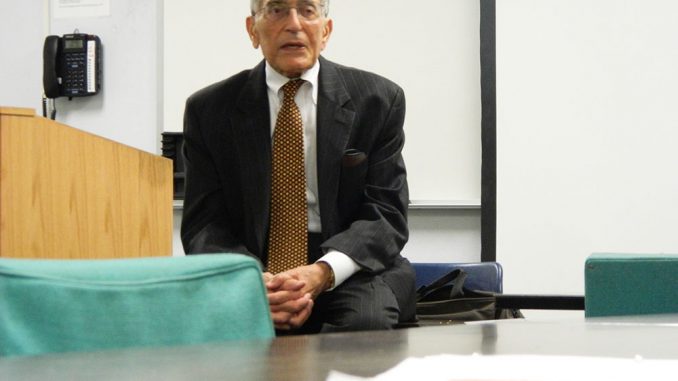
University chancellor David Adamany didn’t leave his term at Temple when his presidency ended.
After six years as the university president, Adamany, 77, became a professor of American politics in the undergraduate political science department and graduate law professor at Beasley School of Law.
Adamany’s presidency at Temple began in 2000 and ended in 2006, a period when some of the school’s most formative changes occurred. During his presidency, Adamany worked to make Temple a more accredited university and begin some of the most developmental changes the university would undergo, including new construction and fundraising strategies.
“Temple is a very complicated place,” Adamany said. “We didn’t have a major fundraising campaign since the late 1970s, so I hired a very fine vice president for development, Stuart Sullivan, to build a fundraising organization. Our fundraising campaign was set to raise $300 million, and when I left in 2006 we had raised more than $100 million.”
Adamany contributed to the construction of the Tyler School of Art, the addition to the Student Center, the TECH Center and many university housing facilities.
“For the Tyler School of Art, Alter Hall and the new Temple medical school building, we raised the money, found the location and did the planning,” Adamany said. “We also built a new instructional center at the Ambler campus.”
Former president Peter J. Liacouras had shifted the university from commuter to residential, but due to the high volume of new students, there wasn’t enough housing for everyone, Adamany said.
“We obtained the land and got the developer to open it up, and helped to fund Oxford Village, University Village and [the Kardon-Atlantic Terminal Building],” Adamany said. “We expanded the student residential living.”
The general education program, which at the time was a 20-year-old curriculum, posed significant issues to the university. Adamany worked with the Faculty Senate and adopted the program that is utilized now. It was under President Ann Weaver Hart that the program was sent to the Board of Trustees then put into effect the following year.
Adamany’s career path didn’t begin at Temple. Previously, he served as president at Wayne State University in Michigan. He also helped raise money from the state of Michigan for more than 15 years to build a new undergraduate library, which would later be named after him.
After leaving Wayne State, Adamany was approached by Temple. Pleased with the progress Temple had made under Liacouras, Adamany agreed to take the position as long as Howard Gittis was chairman of the board. Together they worked to build the addition to the Student Center, along with many other additions at the university. When Gittis became ill in 2006 and left the board, Adamany resigned from his presidency and began teaching at Temple.
“One of the greatest moments at Temple was when I was able to be involved with the students,” Adamany said. “The many, many contacts with students were the best part of the job in many ways.”
Adamany studied at Harvard Law School before returning to his home state of Wisconsin, where he worked as a lawyer for the state government.
Adamany enrolled in graduate courses at the University of Wisconsin, and with the student enrollment growing rapidly, Adamany was asked to teach an introductory course in American politics there.
He said the experience was when he fell in love with teaching.
“When you’re president, you’re meeting with students all of the time, working with them on campus issues and problems,” Adamany said. “But when you’re teaching, you’re not so much dealing with issues and problems, you’re dealing with a subject students want to learn and you’re helping them to do something they want to do. The students taking that course get to talk to me about their own careers and future, and I find that to be a very nice relationship.”
Along with academic life and being a lawyer, Adamany served in the state government as a cabinet officer under the governor of Wisconsin. He was head of the state revenue department, in charge of collecting taxes. He helped make decisions on tax policy, administering taxes and planning a budget within the state’s revenue.
“It was a very good opportunity to work with citizens and make things a little bit better,” Adamany said.
Adamany said he has found academia to be rewarding due to the relationships he developed with students. He said they are the most memorable experiences he would take from his career.
“I really have loved academic life,” Adamany said.
Shayna Kleinberg can be reached at shayna.kleinberg@temple.edu.


Be the first to comment